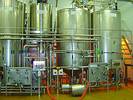

Until recently, Chamdor Brewery on the West Rand has been the Cinderella of the SA Breweries group, living in the shadow of the super-breweries such as Alrode, Prospecton and Rosslyn. Recent developments aimed at transforming it into the `lead flexible brewery' in SAB by 2007 have got the plant on the 'GO', so to speak. Short for Golden Opportunities, GO- aims to create opportunities through reduced time-to-market and rapid market mix responsiveness, involving brewing and packaging a wide range of brand and pack types.
As well as its extreme flexibility as a production brewery (over 1500 brand and pack changes in the past year), Chamdor is regularly used for testing new concepts, equipment and materials. It is therefore the brewery of choice for new people initiatives. In the midst of all this, Chamdor is in a process of rehabilitation to bring it up to date in terms of technology and efficiency, to improve the facility's basic capability to meet the stiff targets it has set itself.
Ram-Tec Systems (RTS) has played a leading role in the first stages of this renewal, including the key brewhouse batch upgrade. The project was dubbed 'Mpfuxelelo' - which is iXitsonga for 'renewal'. This title, suggested by the brewery's operational staff, encapsulates the revival that is taking place at Chamdor.

Brewhouse upgrade
The trickiest jobs are often the ones involving upgrades to existing systems. These are urgently needed modifications when there is little or no stoppage time available to implement the necessary changes. This was the case with the upgrade to the Chamdor brewhouse - and as is often the case with older installations (the brewery has been in operation since 1973), changes that had been made meant that the documentation and I/O lists needed to be validated. To compound the problem, the system had evolved over many years. Accumulated alterations had resulted in the two streams (for producing different beers), together with the CIP (clean in place) system, were controlled by three Quantum PLCs. This would not have been a problem, except that the I/O of the PLCs controlling the two brewing streams and the CIP overlapped.
The PLCs were controlling bits and pieces of three different systems. Obviously, this was not ideal, and the goal was to rearrange the system with one PLC per brewing stream, and the third PLC controlling the CIP. All of this had to be done without stopping the process.
Rescue bus
A system was devised whereby the I/O would be re-incorporated via a combination of Profibus and A-Si. Profibus DP formed the backbone of the system, with interfaces to Profibus PA and A-Si. The existing on-off valves were retained, as were the existing 4 to 20 mA field devices. Some new instruments were added for improved control, and these were fully-fledged Profibus instruments, connected to the Profibus PA segment. New proximity switches were added and, although the existing in-line on-off valves were retained, the solenoid valves driving them were replaced with A-Si devices. A-Si also took care of the existing 4-20 mA devices, via A-Si analog I/O.
Now the small problem of making the physical changes using the existing PLC software had to be addressed to ensure minimum stoppage time. This was accomplished by disconnecting the existing I/O modules and, using the Peer-Cop facility of Modbus Plus, mapping the bus-connected devices to the I/O references in the existing PLC software.
Fortunately, all of this could be pre-checked at Ram-Tec's premises, to verify correct functioning with the existing software - a feat greatly simplified with bus technology. This was an interim solution, as a longer stoppage was scheduled for a few months later, and the software was rewritten to keep the control of the three processes to the relevant individual PLCs.
All of the above links to the scada system - which incorporates batch technology to the international S88 standard. The way in which this upgrade was devised and implemented, meant that what could have been a messy upgrade, turned into a virtually seamless changeover to the new system, with a minimum of production stoppage time.

© Technews Publishing (Pty) Ltd | All Rights Reserved